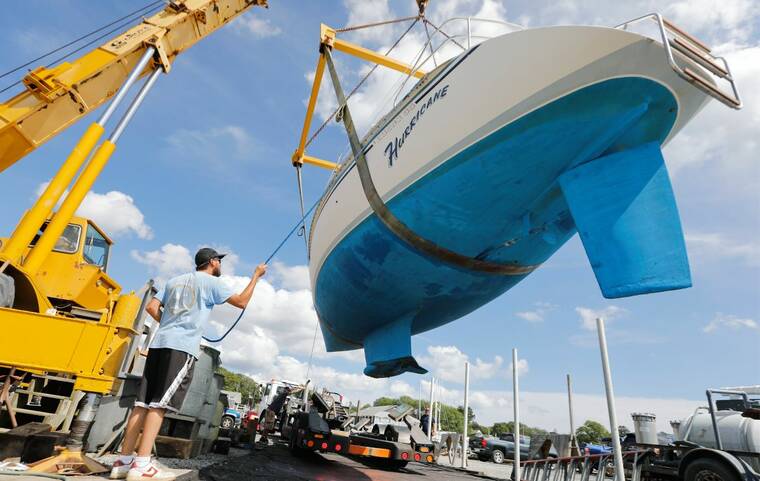New England, eastern Canada hunker down as Hurricane Lee approaches


PETER PEREIRA/THE STANDARD-TIMES VIA ASSOCIATED PRESS
Davis & Tripp Marina and Boat Yard crews pull a sailboat named Hurricane from the waters of Padanaram Harbor in Dartmouth, Mass., Thursday, in preparation for the possible arrival of Hurricane Lee.


PORTLAND, Maine >> New England harbors and fishing villages were being emptied of boats — and becoming ghost towns — as commercial fishermen and recreational boaters scrambled today to make final preparations for the arrival of Hurricane Lee, a storm threatening to bring tropical-storm-force winds across a swath hundreds of miles wide.
Hundreds of out-of-state utility workers poured into Maine amid fears of widespread power outages because of a combination of heavy winds and rain-saturated soil in the nation’s most heavily wooded state.
A tropical storm warning was in place from Maine to Massachusetts, but forecasters removed a hurricane watch for eastern Maine, as the storm with 20-foot ocean swells approached. Forecasters said there would be winds topping 40 mph across an area spanning more than 400 miles ahead of landfall Saturday afternoon.
There was little else to be done today but wait and worry, and make final preparations as Lee, by late morning, was spinning about 395 miles southeast of Nantucket, Massachusetts, and moving away from Bermuda, with maximum sustained winds of 88 mph, according to the National Hurricane Center.
On Long Island, Maine, off of Portland, commercial lobster fisherman Steve Train had just finished hauling 200 traps out of the water. Train, who is also a firefighter, was going to wait out the storm on the island in Casco Bay.
He was not concerned about staying on the island in the storm. “Not one bit,” he said.
Don't miss out on what's happening!
Stay in touch with breaking news, as it happens, conveniently in your email inbox. It's FREE!
Similarly, the Portland Fish Exchange auction house did not intend to close during the storm, said general manager Robert Vanmeter. He said fishermen had taken boats out of the water and would lose a day at sea, but Monday’s regularly scheduled auction — the next one on the schedule — would take place as planned.
While landfall was projected for nearby Nova Scotia, the Category 1 system was big enough to cause concerns over a wide area even if it weakens to a tropical storm. Parts of coastal Maine could see waves up to 15 feet high crashing down, causing erosion and damage, and the powerful gusts will cause power outages in a state where the ground is already saturated from rain, said Louise Fode, a National Weather Service meteorologist. Up to 4 inches (10 centimeters) of rain was forecast for eastern Maine.
Ahead of Lee’s arrival, a state of emergency was declared for Maine and President Joe Biden granted a disaster declaration requested by Maine Gov. Janet Mills to ensure access to federal resources.
In Canada, Ian Hubbard, a Meteorologist for Environment and Climate Change Canada and the Canadian Hurricane Centre, said Lee won’t be anywhere near the severity of the remnants of Hurricane Fiona, which washed houses into the ocean, knocked out power to most of two Canadian provinces and swept a woman into the sea a year ago.
But residents were warned to be prepared nonetheless.
Canadian Prime Minister Justin Trudeau was convening the incident response group, which meets only to discuss events with major implications for Canada. Consisting of Cabinet ministers and senior officials, it was previously convened over events including the start of the COVID-19 pandemic in 2020 and the record wildfire season this year.
Destructive hurricanes are relatively rare this far to the north, in New England and Atlantic Canada. The Great New England Hurricane of 1938 brought gusts as high as 186 mph (300 kph) and sustained winds of 121 mph (195 kph) at Massachusetts’ Blue Hill Observatory. But there have been no storms packing that much power in recent years.
The region learned the hard way with Hurricane Irene in 2011 that damage isn’t always confined to the coast. Downgraded to a tropical storm, Irene still caused more than $800 million in damage in Vermont.
In Maine, the last hurricane watch declared was in 2008, for Hurricane Kyle, which skirted eastern Maine. The last hurricane to make landfall in Maine was Hurricane Gerda, which hit Eastport in 1969.
Associated Press journalists Rob Gillies in Toronto and Robert F. Bukaty in York, Maine, contributed to this report.




